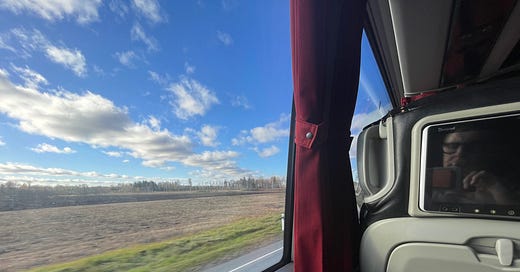When the 'slow road' is the way to go
Slowing down while travelling can often allow more time for immersion, observation and reflection.
Where train or bus is an option I prefer this to short haul flights, if time allows. That said, when you factor in how early you need to get to an airport, wait for the counter to open, queue to check-in, endure immigration and snaking security lines (including disrobing and unpacking daypack of digital devices etc).
Then more waiting and queuing at the gate. Plus the premium prices of airport catering, and for shorter distances, trains or buses make much better sense (and ‘cents’).
Which is what I did recently; opting for the Lux Express bus from Riga in Latvia to Tallinn, Estonia. When booking via the app, I chose a lounge seat (like a single 1st class seat in a 1x2 configuration). Half the bus had the standard 2x2 seat/row configuration. Not seen that before, and I’ve sampled my share of long distance buses across 5 continents over the decades.
Here’s what I encountered:
More leg room than a business class seat on an aircraft.
Its toilet was more spacious and cleaner than anything endured on an aircraft.
20 times the viewing window than on a window seat on a plane
Still had a built in TV screen in the seat back with the latest movies, TV shows on demand, plus Google Maps tracking the journey (there was free WiFi as well)
Heaps of device charging options built into the seats (more than any aircraft I’ve seen)
Disembarkation, bag collection and taxi connection took 3 minutes (compare that to an international flight experience)
It’s invariably a greener, cleaner and more comfortable travelling experience.
You get to see far more of the countryside, up close.
And here’s the kicker. All that comfort and convenience for a 5 hour journey from Riga to Tallinn cost 25 euros. That’s not a typo. A comparable fare with local carrier, Air Baltic, costs around 150 euros for the exact same route, and taking about the same length of time.
But more broadly speaking, I think there is a curious kind of magic in slowness when ‘on the road’. It invites a spontaneity in your decision making because it fosters the likelihood of unplanned interactions or diversions. Paths unfold when you loosen that grip on taut pre-planned schedules.
And I’m not just talking about the pace of travel here. The ‘slow road’ can be an orientation towards experience itself. Because when you decline or resist the fast track, you can become more porous to the world, allowing journeys or places or even people to seep into you in ways no itinerary can predict.
The hurried traveler ticks off landmarks. You see them with their phone cameras, pointing this way and that in constant motion, all the while tracking progress between pins on a map or a top-10 checklist.
Later, swiping through their photo library will feel like skimming thumbnails from a life briefly borrowed. Conversely, the traveller who moves slowly learns that the places that matter most aren’t always found on a map or a TripAdvisor review.
The other big thing about slowness is that you notice. That crinkle of a stranger’s newspaper, that shifting pattern of light or incense smoke in a temple’s air, the ebb and flow of everyday life. It’s more sensory too.
But these observations are not distractions; they are the very marrow of travel, informing without being asked, as long as the traveller is attuned to the possibility. In this context, way-finding moves from guidebooks to glances, overheard words, and unplanned conversations.
And then there’s the world itself; the landscapes that open up not as backdrops to our movement but as protagonists in their own right, as seen from seat 36 on my Lux Express bus.
By travelling slowly, we stand a better chance of encountering the planet on its own terms. Foregoing a flight means that that train or bus through the countryside reveals not just vistas but rhythms: the rise and fall of fields, the sway of crops, the views into backyards and windows, the contours of a landscape, none of which is shaped for our convenience.
To move slowly is, in some small way, an act of respect. Slowness acknowledges that the places we pass through are not props for our experience but living entities with their own enticing narratives.
In this way, the slow road teaches us that travel isn’t about conquering distances the fastest way possible, but more about surrendering to it. And in that surrender, we can discover what it means to truly arrive—not at a destination, but a better appreciation of our place in the world.




